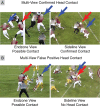Comparison of video-based and sensor-based head impact exposure
- PMID: 29920559
- PMCID: PMC6007917
- DOI: 10.1371/journal.pone.0199238
Comparison of video-based and sensor-based head impact exposure
Abstract
Previous research has sought to quantify head impact exposure using wearable kinematic sensors. However, many sensors suffer from poor accuracy in estimating impact kinematics and count, motivating the need for additional independent impact exposure quantification for comparison. Here, we equipped seven collegiate American football players with instrumented mouthguards, and video recorded practices and games to compare video-based and sensor-based exposure rates and impact location distributions. Over 50 player-hours, we identified 271 helmet contact periods in video, while the instrumented mouthguard sensor recorded 2,032 discrete head impacts. Matching video and mouthguard real-time stamps yielded 193 video-identified helmet contact periods and 217 sensor-recorded impacts. To compare impact locations, we binned matched impacts into frontal, rear, side, oblique, and top locations based on video observations and sensor kinematics. While both video-based and sensor-based methods found similar location distributions, our best method utilizing integrated linear and angular position only correctly predicted 81 of 217 impacts. Finally, based on the activity timeline from video assessment, we also developed a new exposure metric unique to American football quantifying number of cross-verified sensor impacts per player-play. We found significantly higher exposure during games (0.35, 95% CI: 0.29-0.42) than practices (0.20, 95% CI: 0.17-0.23) (p<0.05). In the traditional impacts per player-hour metric, we observed higher exposure during practices (4.7) than games (3.7) due to increased player activity in practices. Thus, our exposure metric accounts for variability in on-field participation. While both video-based and sensor-based exposure datasets have limitations, they can complement one another to provide more confidence in exposure statistics.
Conflict of interest statement
The authors are developing the Stanford Mouthguard used in this study as a research device to study mild traumatic brain injury, and the findings of this study may help inform sensor design. Some of the authors are coinventors on Stanford-owned patents related to head impact detection (patent 14/199,716: “Device for Detecting On-Body Impacts” with Lyndia Wu and David Camarillo listed as inventors) and mechanical design (patent 15/373,454: “Oral Appliance for Measuring Head Motions by Isolating Sensors from Jaw Perturbance” with Calvin Kuo, Lyndia Wu, and David Camarillo listed as inventors) of an instrumented mouthguard. This does not alter our adherence to PLOS ONE policies on sharing data and materials.
Figures







References
-
- Thurman DJ, Branche CM, Sniezek JE. The epidemiology of sports-related traumatic brain injuries in the United States: recent developments. [Internet]. The Journal of head trauma rehabilitation. 1998. pp. 1–8. doi: 10.1097/00001199-199804000-00003 - DOI - PubMed
-
- Broglio SP, Puetz TW. The Effect of Sport Concussion on Neurocognitive Function, Self-Report Symptoms and Postural Control. Sport Med. 2008;38: 53–67. - PubMed
-
- King D, Brughelli M, Hume P, Gissane C. Assessment, management and knowledge of sport-related concussion: Systematic review. Sport Med. 2014;44: 449–471. doi: 10.1007/s40279-013-0134-x - DOI - PubMed
-
- Patel DR, Shivdasani V, Baker RJ. Management of sport-related concussion in young athletes. [Review] [115 refs]. Sport Med. 2005;35: 671–684. doi: 10.2165/00007256-200535080-00002 - DOI - PubMed
-
- Beckwith JG, Greenwald RM, Chu JJ, Crisco JJ, Rowson S, Duma SM, et al. Head Impact Exposure Sustained by Football Players on Days of Diagnosed Concussion. Med Sci Sports Exerc. 2013;45: 737–746. doi: 10.1249/MSS.0b013e3182792ed7 - DOI - PMC - PubMed
Publication types
MeSH terms
LinkOut - more resources
Full Text Sources
Other Literature Sources
Medical

